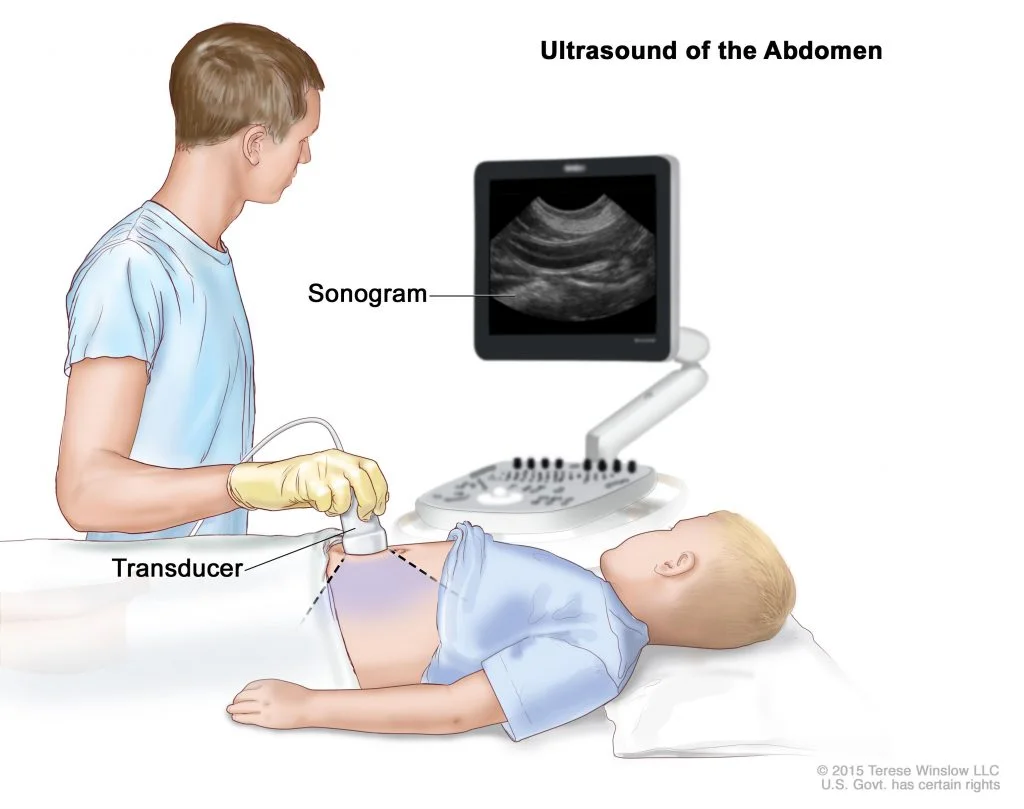
Abdominal ultrasound
An abdominal ultrasound in Nagpur is a non-invasive medical imaging technique that uses high-frequency sound waves to produce images of the organs and structures in the abdominal cavity. It can be used to assess the following:
1. Liver
2. Gallbladder
3. Pancreas
4. Kidneys
5. Spleen
6. Stomach
7. Small intestine
What is an Abdominal Ultrasound?
Procedure – A non-invasive test technology that employs high-frequency sound waves to capture pictures of the organs and structures within the abdominal cavity. Also known as abdominal sonography and ultrasonography of the abdomen.
What is an Abdominal Ultrasound used for?
Abdominal Ultrasound assesses tenderness or discomfort of the abdomen. It is a diagnostic process to diagnose gallstones or kidney stones. It can help diagnose liver diseases, including cirrhosis and cancer. This procedure can also determine a pancreatitis and pancreatic cancer. This can also help in detecting kidney diseases or cancers. It can monitor the blood flow to organs in the abdominal area.
They direct biopsies or cancer therapy
They examine abdominal injuries or trauma
How is Abdominal Ultrasound performed?
The procedure may be performed by a sonographer or a radiologist and usually lasts between 30 minutes to an hour. A patient can lie on the examination table, while a transducer is pressed against the abdomen. Gel is used on the transducer to promote better imaging. Images are then displayed on a monitor for a real-time interpretation.
There are kinds of Abdominal Ultrasound
-Conventional 2D ultrasound
-Doppler ultrasound, which checks the blood flow
-Contrast-enhanced ultrasound, which is performed by enhancing organs and structures using a contrast agent
-3D and 4D ultrasound, that gives detailed images of organs and structures
Benefits of Abdominal Ultrasound
– It is not invasive as well as painless
– No ionizing radiation
– Real-time images give immediate diagnosis
– Much less expensive than other imaging modalities
– Portable and available almost everywhere
Disadvantages of Abdominal Ultrasound
– The quality of the image depends upon body size and composition
– Will not detect all abdominal conditions or diseases.
– May be of limited depth penetration, which is a problem in the imaging of deep structures.
What Is a Abdominal ultrasound?
Abdominal ultrasound – a medical imaging technique that provides highly penetrating, non-invasive images of organs and structures in the abdominal cavity using high-frequency sound waves. -Evaluates the following organs:
-Liver
-Gallbladder
-Pancreas
-Kidneys
-Spleen
-Stomach
-Small intestine
-Large intestine (colon)
-Abdominal blood vessels
Application of abdominal ultrasound: Abdominal ultrasound is conducted in the detection and monitoring of many conditions related to the abdomen, such as:
-Gallstones
-Kidney stones
-Liver disease
-cirrhosis
-liver cancer
-Pancreatitis
-Pancreatic cancer
It includes
Renal disease
Injuries/trauma to the abdominal region
It is safe, pain-free, and easily accessible to any medical facility, able to give real-time images of abdominal organs and structures in aid of proper decision-making in patient care.
What procedures Abdominal ultrasound?
In abdominal ultrasound procedures, we have the following:
1. Right Upper Quadrant (RUQ) Ultrasound: This is the examination of the liver, gallbladder, and bile ducts.
2. Liver Ultrasound: This assesses the size and texture of the livers along with the blood flow in it.
3. Gallbladder Ultrasound: It observes gallstones and the functioning of the gallbladder.
4. Pancreatic Ultrasound: This evaluates the pancreas to be inflamed or to contain tumors or cysts.
5. Kidney Ultrasound: This test observes the size and shape of the kidney, along with blood flowing in it.
6. Renal Doppler Ultrasound: This is a sort of duplex scan, where the observer studies blood flow into the kidneys.
7. Spleen Ultrasound: This is further examining the size and texture of the spleen.
8. Abdominal Aorta Ultrasound: Examination of the abdominal aorta for aneurysm or dissection.
9. Inferior Vena Cava Ultrasound: Visualization of blood flow in the inferior vena cava.
10. Complete Abdominal Ultrasound: Thorough examination of the abdominal structures and organs
These tests are applied for diagnostic purposes and for monitoring in cases with gallstones, liver disease, pancreatitis, kidney diseases, and abdominal injury or trauma.
Hence, specific procedures and components thereof vary based on the circumstances of people and upon the guidelines of healthcare providers.
At our Neurosys Multispeciality Center, we perform several key procedures including Craniotomy, which is primarily for the excision of brain tumors; V-P Shunt Surgery for treating hydrocephalus; surgeries for epilepsy; and operations targeting brain stem glioma. Beyond these, we offer a range of other neurosurgical services. If you have any questions that are not answere, please contact us through our Contact Us or Book your Appointment.
